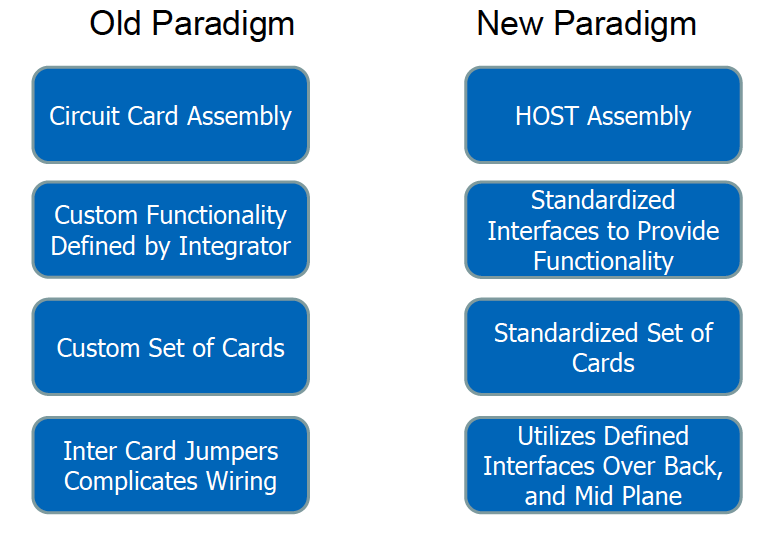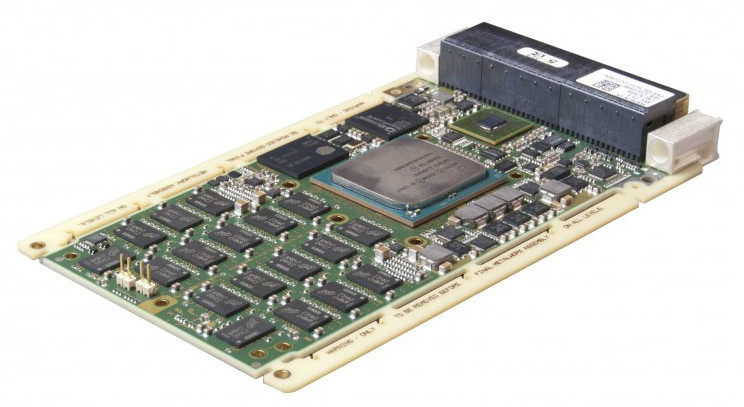BY PATRICK MANNION, contributing editor
Under a veneer of bells and whistles lies a history of military embedded systems development fraught with missed deadlines, cost overruns, and behind-the-curve technology. This may be about to change with the uncharacteristically rapid consolidation of support by all three armed services behind the Hardware Open System Technology (HOST) effort.
“Today, the systems and trends that the government wants are growing more and more complex, and to get them to field is growing more and more costly,” said Patrick Collier, Open Systems Hardware engineer at NAVAIR. “So unless we do something about it, it’s going to break: There’s going to be no way that we can field any kind of complicated system given the cost that it’s going to incur to the government.” (Fig. 1 ).

Fig. 1: In an unusual show of unity, the U.S. Air Force, Army, and Navy are getting behind HOST in an effort to drive down costs and get advanced systems fielded faster. (Image source: FACE Consortium)
Collier was speaking specifically in the context of the Air Force’s Sensor Open Systems Architecture (SOSA) at the recent Embedded Tech Trends event in New Orleans. SOSA is a standardization effort focused on avionics sensors and peripherals processing that is already working hard to reduce the cost and time to get new technology into the field. It comprises five groups:
- Electromechanical: working on specifications for connectors and interfaces to connect existing payloads to the platforms
- Business: working on marketing, contracts, IP, and business development
- Enterprise: working on the overarching architecture for SOSA to define terms and functions from one application to the next
- Software: working on software portability and third-party application programming interfaces (APIs)
- Hardware: This is the group that Collier leads within SOSA and it is charged with defining the next-gen system boxes that he said would leverage OpenVPX.
Along with SOSA, the Air Force also spearheaded the development of the Future Airborne Capability Environment (FACE), which is solely focused on software development and portability in an effort to lower development costs. Both SOSA and FACE are underpinnings for HOST.
Though Collier is employed by the Navy’s Naval Air Systems Command (NAVAIR), he underscored the unifying purpose of HOST by pointing to its early intentions: “To provide a framework for developing embedded computing systems for U.S. military platforms. HOST provides U.S. government acquisition, systems integrators, and third-party component vendors with an open, interoperable, upgradeable, and sustainable embedded system standard.”
Compared to how systems are currently contracted, the HOST paradigm will have standard interfaces and functions at more levels with standard cards and backplanes (Fig. 2 ).

Fig. 2: Using the SOSA model, HOST breaks down applications into blocks with standard functions and interfaces that will run on standard cards and across standard backplanes. (Image source: NAVAIR)
HOST is incorporating SOSA’s model of breaking down an application’s technology into building blocks that can be reused across other applications on different platforms. “A year ago, the Army, Navy, and Air Force decided that we’re all using the same thing and working with the same standards, so we wanted to leverage that,” said Collier. In the case of SOSA, the sensor application for ruddering or other functional profile on an aircraft likely has a corollary in an Army land vehicle or a Navy surface vessel.
Breaking vendor locks
Along with reducing cost, promoting reuse, and shortening fielding times, Collier also emphasized the need to break vendor locks. “We want to avoid going back to the same vendor day in and day out,” he said. This desire to break the locks of custom or semi-custom designs isn’t unusual.
The Advanced Telecommunications Computing Architecture (ATCA) is a good example of a standard that came together for similar purposes but in the context of communications. However, that standard effort ran into trouble for various reasons, one of which was cost. “By the time you built everything based on the [ATCA] standard, your cost points prohibit you from going to market,” said Sven Freudenfeld, Global Business Development Director for Telecom Appliances at Lanner Electronics, Inc. Lanner instead took a hybrid approach, taking some ATCA features and developing the HTCA-6000 platform, optimized for high-reliability telecommunications but also bridging into the data center.
The Lanner deviation from ATCA due to high cost and the need to differentiate underscores the problem of aiming too high with standards. Another effect of standards is homogeneity of solutions, which can be good or bad. While HOST’s intent is to break vendor lock, the flip side of vendor lock is the opening of bids for all comers. For the installed base of vendors to the military, this is not good news because they are now on an equal footing with all newcomers.
However, for a U.S. government that is fighting to lower costs, this situation is ideal. If HOST takes off as planned, the military will have multiple developers supplying somewhat similar hardware and software that can be applied across air, land, and sea. It is a good opportunity to lower costs through more competitive bids.
For embedded technology vendors that have been effectively locked out of military contracts, they now have an opportunity to bid for embedded systems contracts and bid for their share of the $639 billion 2018 military budget.
Rallying around OpenVPX
The degree to which all three armed services are working together is clearly unusual and has surprised Jerry Gipper, executive director of VITA. “I’ve never seen anything quite like this before,” he said. A veteran of the VMEbus/Multibus wars of the ’80s and early ’90s, Gipper was also behind Futurebus+. However, FB+ didn’t go anywhere — in large part because of costs, but also because it was too undefined, said Gipper. “Nobody stepped up to say, ‘OK, we want to use gigabit Ethernet; here’s the size and pins that we want and this is what we’re going to use.’”
This clarity down to the pin level is exactly what HOST is providing, working off OpenVPX, and it has already defined the connector pinouts. From Gipper’s vantage point, this is, in part, why it’s taking off rapidly and getting so much interest. “The HOST Webex conference calls that I run have gone from a license for 25 people to needing a license for 200 in just the past few months,” he said.
The difference between HOST and other standards efforts is that, thanks to the work behind VPX and OpenVPX, products are already available from companies such as Curtiss-Wright, Abaco Systems, and Mercury Computer. As a result, Lockheed Martin, Northrup Grumman, and CERDEC are already building out systems to SOSA — and, soon, HOST — requirements.
OpenVPX for HOST
OpenVPX is being developed under the VITA 65 working group and is currently on version 65.0 and 65.1. The baseline VPX standard emerged in 2007 as the next step beyond VME64 and VXS after it became clear that both a serial switch fabric and more pins were needed. VPX supports gigabit Ethernet as well as Infiniband, Serial RapidIO, and PCI Express. It builds off of VME with both 6U and 3U form factors. VPX was followed by OpenVPX in 2010 in an effort to provide a systems-level approach to VPX.
The system and functional standardization of OpenVPX is a fundamental attribute that will enable HOST’s long-term intent. Over the next 10 to 15 years, Collier expects that the applications database will grow and allow quick identification of functions that can be turned into building blocks and modules to maximize reuse.
In the meantime, vendors such as Abaco Systems continue to build the currently available OpenVPX inventory. In late March, it announced the OpenVPX-based SBC367D, a 3U, 40-Gigabit-Ethernet (GbE) card based on the Intel Xeon D-1500 processor family (Fig. 3 ).

Fig. 3: Abaco Systems’ SBC367D OpenVPX single-board computer (SBC) supports 40 GbE and is based on a 16-core Intel Xeon D-1500 processor.
The board is “mission-ready” and comes with 32 Gbytes of DDR4 SDRAM and comes as an Ethernet alternative to Abaco’s PCI Express-oriented SBC347D. While Ethernet was initially overlooked because it is non-deterministic, its scalability across multi-module architectures and rapidly increasing performance matches the evolving needs of military and avionics applications.
Along with 40-GbE support, the SBC367D comes with a range of security features to support Anti-Tamper and Information Assurance strategies. These include an inherently secure FPGA solution with Microsemi’s SmartFusion2 and support for Intel’s Trusted Execution Technology.
Advertisement





